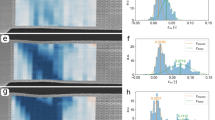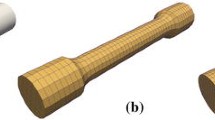Abstract
Meshfree methods for solid mechanics have been in development since the early 1990’s. Initial motivations included alleviation of the burden of mesh creation and the desire to overcome the limitations of traditional mesh-based discretizations for extreme deformation applications. Here, the accuracy and robustness of both meshfree and mesh-based Lagrangian discretizations are compared using manufactured extreme deformation fields. For the meshfree discretizations, both moving least squares and maximum entropy are considered. Quantitative error and convergence results are presented for the best approximation in the \(H^1\) norm.


















Similar content being viewed by others
References
Anderson J (1984) Fundamentals of aerodynamics. McGraw Hill, New York
Arroyo M, Ortiz M (2006) Local maximum-entropy approximation schemes: a seamless bridge between finite elements and meshfree methods. Int J Numer Methods Eng 65(13):2167–2202
Belytschko T, Krongauz Y, Organ D, Fleming M, Krysl P (1996) Meshless methods: an overview and recent developments. Comput Methods Appl Mech Eng 139(1–4):3–47
Belytschko T, Krysl P, Krongauz Y (1997) A three-dimensional explicit element-free Galerkin method. Int J Numer Methods Fluids 24(12):1253–1270
Bishop J (2009) Simulating the pervasive fracture of materials and structures using randomly close packed Voronoi tessellations. Comput Mech 44(4):455–471
Bonet J, Wood R (2008) Nonlinear continuum mechanics for finite element analysis, 2nd edn. Cambridge University Press, Cambridge
Chen J, Pan C, Wu C, Liu WK (1996) Reproducing kernel particle methods for large deformation analysis of non-linear structures. Comput Methods Appl Mech Eng 139(1):195–227
Chen J, Hillman M, Ruter M (2013) An arbitrary order variationally consistent integration for Galerkin meshfree methods. Int J Numer Methods Eng 95(5):387–418
Chen J, Hillman M, Chi S (2017) Meshfree methods: progress made after 20 years. J Eng Mech 143(4):04017001
Dolbow J, Belytschko T (1999) Numerical integration of the Galerkin weak form in meshfree methods. Comput Mech 23(3):219–230
Fitzpatrick R (2017) Theoretical fluid mechanics. IOP Publishing, Bristol
Han W, Meng X (2001) Error analysis of the reproducing kernel particle method. Comput Methods Appl Mech Eng 190(46):6157–6181
Hormann K, Sukumar N (2008) Maximum entropy coordinates for arbitrary polytopes. Comput Graph Forum 27(5):1513–1520
Hughes T (2000) The finite element method: linear static and dynamic finite element analysis. Dover, Mineola
Koester J, Chen J (2019) Conforming window functions for meshfree methods. Comput Methods Appl Mech Eng 347:588–621
Liu W, Jun S, Zhang Y (1995) Reproducing kernel particle methods. Int J Numer Methods Fluids 20(8–9):1081–1106
Liu W, Chen Y, Chang CT, Belytschko T (1996) Advances in multiple scale kernel particle methods. Comput Mech 18(2):73–111
Matlab, Release (2018a). www.mathworks.com. Accessed 31 Jan 2019
Organ D, Fleming M, Terry T, Belytschko T (1996) Continuous meshless approximations for nonconvex bodies by diffraction and transparency. Comput Mech 18(3):225–235
Rider W, Kothe D (1998) Reconstructing volume tracking. J Comput Phys 141(2):112–152
Smolarkiewicz P (1982) The multi-dimensional Crowley advection scheme. Mon Weather Rev 110(12):1968–1983
Strang G, Fix G (2008) An analysis of the finite element method, 2nd edn. Wellesley-Cambridge Press, Wellesley
Sukumar N (2004) Construction of polygonal interpolants: a maximum entropy approach. Int J Numer Methods Eng 61(12):2159–2181
Sukumar N, Malsch E (2006) Recent advances in the construction of polygonal finite element interpolants. Arch Comput Methods Eng 13(1):129–163
Sukumar N, Wright R (2007) Overview and construction of meshfree basis functions: from moving least squares to entropy approximants. Int J Numer Methods Eng 70(2):181–205
Acknowledgements
The helpful discussions with Prof. N. Sukumar at UC Davis and use of his Matlab MAXENT functions are gratefully acknowledged. The many helpful discussions with Jake Koester and Mike Tupek at Sandia are gratefully acknowledged. Sandia National Laboratories is a multimission laboratory managed and operated by National Technology and Engineering Solutions of Sandia, LLC, a wholly owned subsidiary of Honeywell International, Inc., for the U.S. Department of Energy’s National Nuclear Security Administration under contract DE-NA-0003525. This paper describes objective technical results and analysis. Any subjective views or opinions that might be expressed in the paper do not necessarily represent the views of the U.S. Department of Energy or the United States Government. The author states that there is no conflict of interest.
Author information
Authors and Affiliations
Corresponding author
Additional information
Publisher's Note
Springer Nature remains neutral with regard to jurisdictional claims in published maps and institutional affiliations.
Appendices
Appendix A: Deformation field \(\mathscr {D}_2\)
The following stream function is a classical example from fluid mechanics representing the incompressible inviscid flow around a cylinder [1]. By choosing an appropriate initial material body, this deformation resembles the impact of projectile onto a ductile plate. Actual penetration is not possible, however, due to continuity of the deformation. The stream function, \(\Psi \), is defined using polar coordinates \((r,\theta )\), as
where \(r_{\mathrm {o}}\) is the cylinder radius, \(V_\infty \) is the upstream velocity. The velocity components are then given by
In rectangular coordinates, the velocity components are
with \(x_1 = r \cos \theta \), \(x_2 = r \sin \theta \), \(\tan \theta = x_2/x_1 \), and \(r^2 = x_1^2 + x_2^2\).
The components of the velocity gradient are then
Normalizing, let \(V_\infty =1\) and \(r_{\mathrm {o}}=1\), and if the material body \(\mathscr {B}\) is chosen to be the rectangle body \([-2,-1]\times [-3,3]\), the deformation shown in Fig. 19 is obtained.
Additional two-dimensional deformation fields can be defined similarly using the stream function approach including axisymmetric flows. For example, the stream function for axisymmetric flow around an ellipsoid is given in [11].
Appendix B: Convergence data
For completeness, the convergence results presented in Figs. 14–17 are also given in Tables 1, 2, 3, 4, 5, 6, 7, 8, 9, and 10. Several of the finite element results were not computable (NC) for the highly distorted meshes (\(s=0.4\) and \(s=0.5\)). All results are normalized by the respective norm of the exact solution.
Rights and permissions
About this article
Cite this article
Bishop, J. A kinematic comparison of meshfree and mesh-based Lagrangian approximations using manufactured extreme deformation fields. Comp. Part. Mech. 7, 257–270 (2020). https://doi.org/10.1007/s40571-019-00256-x
Received:
Revised:
Accepted:
Published:
Issue Date:
DOI: https://doi.org/10.1007/s40571-019-00256-x





